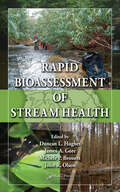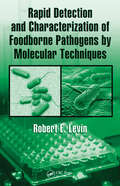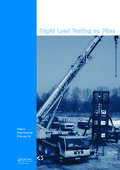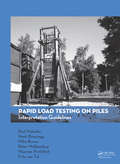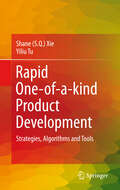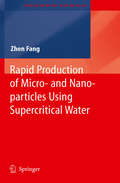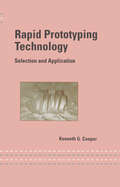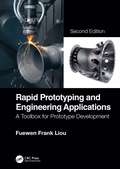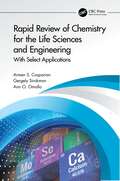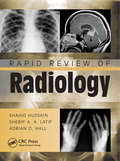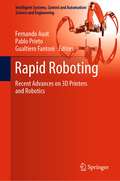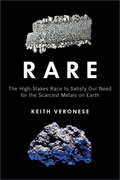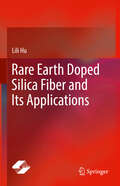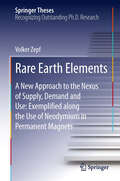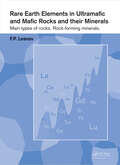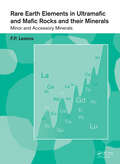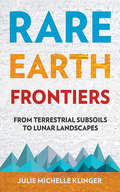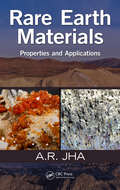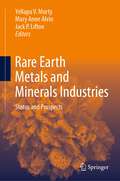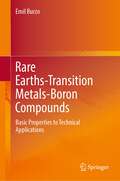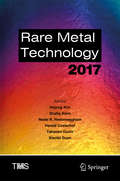- Table View
- List View
Ransomware Revolution: The Rise of a Prodigious Cyber Threat (Advances in Information Security #85)
by Matthew RyanThis book explores the genesis of ransomware and how the parallel emergence of encryption technologies has elevated ransomware to become the most prodigious cyber threat that enterprises are confronting. It also investigates the driving forces behind what has been dubbed the ‘ransomware revolution’ after a series of major attacks beginning in 2013, and how the advent of cryptocurrencies provided the catalyst for the development and increased profitability of ransomware, sparking a phenomenal rise in the number and complexity of ransomware attacks. This book analyzes why the speed of technology adoption has been a fundamental factor in the continued success of financially motivated cybercrime, and how the ease of public access to advanced encryption techniques has allowed malicious actors to continue to operate with increased anonymity across the internet. This anonymity has enabled increased collaboration between attackers, which has aided the development of new ransomware attacks, and led to an increasing level of technical complexity in ransomware attacks. This book highlights that the continuous expansion and early adoption of emerging technologies may be beyond the capacity of conventional risk managers and risk management frameworks.Researchers and advanced level students studying or working in computer science, business or criminology will find this book useful as a reference or secondary text. Professionals working in cybersecurity, cryptography, information technology, financial crime (and other related topics) will also welcome this book as a reference.
Rapid Bioassessment of Stream Health
by John R. Olson Duncan L. Hughes James Gore Michele P. BrossettTasked by the Clean Water Act to restore and maintain the integrity of their waters, state and local governments must develop systems for assessing the health of the streams within their borders. They quickly find that one size does not fit all when it comes to sampling. Rapid Bioassessment of Stream Health examines the sampling techniques, laborat
Rapid Detection and Characterization of Foodborne Pathogens by Molecular Techniques
by Robert E. LevinWritten by one of the most prolific and respected researchers in food safety, this volume describes molecular techniques for the detection and discrimination of major infectious bacteria associated with foods. Each chapter deals with a specific organism and techniques applied to that organism. Particular focus is placed on genes associated with pathogenicity used in the polymerase chain reaction (PCR) including real-time PCR for specific detection of pathogenic bacteria and the inherent limitations of such methodology with certain pathogens. Methods for extracting microorganisms from complex food matrices andDNA purification techniques are also emphasized.
Rapid Load Testing on Piles
by Paul Hölscher Frits Van TolTo obtain data about the stiffness and bearing capacity of a foundation pile, the Rapid Load Test could be an effective and economic alternative for a static load test. In order to judge this, the influence of rate effects in clay and pore water pressures in sand should first be understood. This book presents the latest developments in the research
Rapid Load Testing on Piles: Interpretation Guidelines
by Paul Holscher Henk Brassinga Michael Brown Peter Middendorp Maarten Profittlich Frits A. van TolA Rapid Load Test (RLT), developed to determine the initial stiffness and bearing capacity, is an economical and practical alternative to a Static Load Test (SLT). The broad application of RLT, however, was hampered by uncertainty about the interpretation of the test results. This book offers clear guidance on the available analysis techniques and
Rapid One-of-a-kind Product Development
by Shane Shengquan Xie Yiliu TuRapid One-of-a-kind Product Development discusses research in the development of new enabling technologies for small and medium companies. Scientific advancements presented include a novel product data modelling scheme to model product design, manufacturability and knowledge under a common data object; customised product development in a distributed environment; and new adaptive scheduling methods for the optimal production of a wide variety of customised products, taking into consideration all of the possible changes from customers and the uncertainties in manufacturing. The book also includes research towards a computer aided customer interface, which allows customer requirements and changes to be processed and integrated with technical designs in real time; adaptive and concurrent CAD methods and algorithms; and product modelling and system integration technologies. The reader will learn how to: * translate customer requirements to technical attributes; * develop new and innovative products to meet customer requirements and expectations; * evaluate and optimise a project design; * design production systems and use them efficiently; and * manage a variety of customised products. Rapid One-of-a-kind Product Development demonstrates how to develop new methods, tools and algorithms to address the problems in a mass customisation environment. It is a valuable source of information for researchers and engineers in the fields of design and manufacturing.
Rapid Production of Micro- and Nano-particles Using Supercritical Water
by Zhen FangThis book shows how to use supercritical water (SCW) to synthesize nano- and micro- oxides, inorganic salts and metal particles and its recent advancement. Also polymer/biomass particles can be produced by using the method of precipitation of solutes from SCW. The particles can be used as catalysts for biomass conversions, materials in ceramics & electronic devices and composite materials. Particles are easily produced continuously in a flow reactor in short and long reaction times. Besides the synthesis process, the book also present studies of the properties of these materials. The size, size distribution, crystal growth & structure, and morphology of particles produced by supercritical water can be controlled by the feed concentrations, pH, pressures, temperatures, heating & cooling rates, organic modifications, reducing or oxidizing atmospheres, flow rates and reaction times.
Rapid Prototyping Technology: Selection and Application
by Kenneth CooperReviews operation principles and methods for most Solid Freeform technologies and historical systems data. Illustrates the uses and mechanical details for a number of systems, including JP-System 5, Ballistic Particle Manufacturing, Fused Deposition Modeling, Laminated Object Manufacturing, Stereolithography, and Selective Laser Sintering.
Rapid Prototyping and Engineering Applications: A Toolbox for Prototype Development, Second Edition
by Fuewen LiouSince the publication of the first edition, several Additive Manufacturing technologies have been invented, and many new terminologies have been formalized. Each chapter has been brought up-to-date so that this book continues with its coverage of engineering procedures and the application of modern prototyping technologies, such as Additive Manufacturing (AM) and Virtual Prototyping (VP) that quickly develops new products with lower costs and higher quality. The examples, practice exercises, and case studies have also been updated. <P><P>Features <li>Gears toward rapid product prototyping technologies <li>Presents a wide spectrum of prototyping tools and state-of-the-art additive manufacturing technologies <li>Explains how to use these rapid product prototyping tools in the development of products <li>Includes examples and case studies from the industry <li>Provides exercises in each chapter along with solutions
Rapid Refrigeration and Water Protection: Next Generation Adsorbents (Springer Water)
by Rasel Das Bidyut Baran SahaThis book provides a cross-disciplinary, multi-scale assessment of the development of adsorption-based refrigerants and super-adsorbent-based wastewater purification. The book covers two major aspects from the 21st century, including the development of an environmentally benign adsorption cooling system and the preparation of a super-adsorbent for water purification. Although work has been published on these topics, the authors present the latest findings and introduce some new perspectives. The book is written as a reference book with contributions from global field experts and will appeal to water engineers, chemists, environmentalists, physicists, material scientists, nano-technologists, and environmental technologists.
Rapid Review of Chemistry for the Life Sciences and Engineering: With Select Applications
by Armen S. Casparian Gergely Sirokman Ann OmolloTo understand, maintain, and protect the physical environment, a basic understanding of chemistry, biology, and physics, and their hybrids is useful. Rapid Review of Chemistry for the Life Sciences and Engineering demystifies chemistry for the non-chemist who, nevertheless, may be a practitioner of some area of science or engineering requiring or involving chemistry. It provides quick and easy access to fundamental chemical principles, quantitative relationships, and formulas. Armed with select, contemporary applications, it is written in the hope to bridge a gap between chemists and non-chemists, so that they may communicate with and understand each other. Chapters 1–10 are designed to contain the standard material in an introductory college chemistry course. Chapters 11–15 present applications of chemistry that should interest and appeal to scientists and engineers engaged in a variety of fields. Additional features More than 100 solved examples clearly illustrated and explained with SI units and conversion to other units using conversion tables included Assists the reader to understand organic and inorganic compounds along with their structures, including isomers, enantiomers, and congeners of organic compounds Provides a quick and easy access to basic chemical concepts and specific examples of solved problems This concise, user-friendly review of general and organic chemistry with environmental applications will be of interest to all disciplines and backgrounds.
Rapid Review of Radiology (Medical Rapid Review Ser.)
by Shahid Hussain Sherif Aaron Latif Adrian David HallAs in all specialties, learning in radiology is a life long process but for radiologists in training there is a vast amount of information to assimilate. In this book the authors have compiled 191 cases to help the reader with the practical aspects of image recognition and differential diagnosis.The selection of cases is broad enough to provide an
Rapid Roboting: Recent Advances on 3D Printers and Robotics (Intelligent Systems, Control and Automation: Science and Engineering #82)
by Fernando Auat Pablo Prieto Gualtiero FantoniThis book summarizes recent advances in robotics using 3D printers and rapid prototyping as a concept development tool. The book is focused on industrial applications, educational aspects, rehabilitation, and other related topics. In particular, the book is intended to offer the reader a smooth yet deep introduction to the use of 3D printers and rapid prototyping techniques as a solution to robotics and mechatronics problems, highlighting successful case studies.
Rapidly Solidified Alloys: Processes-Structures-Properties-Applications (Materials Engineering)
by Howard H. LiebermannThis volume details the principles underlying rapid solidification processing, material structure and properties, and their applications. This practical resource presents a manifold approach to both amorphous and crystalline rapidly solidified metallic alloys.;Written by over 30 internationally acclaimed specialists in their respective fields, Rapi
Rare
by Keith VeroneseHow will your life change when the supply of tantalum dries up? You may have never heard of this unusual metal, but without it smartphones would be instantly less omniscient, video game systems would falter, and laptops fail. Tantalum is not alone. Rhodium. Osmium. Niobium. Such refugees from the bottom of the periodic table are key components of many consumer products like cell phones, hybrid car batteries, and flat screen televisions, as well as sophisticated medical devices and even weapon systems. Their versatile properties have led manufacturers to seek these elements out to maximize longevity, value, and efficiency, but not without a human price. In addition to explaining the chemistry behind rare earth metals, Rare delves into the economic and geopolitical issues surrounding these "conflict minerals," blending tales of financial and political struggles with glimpses into the human lives that are shattered by the race to secure them. In the past decade, the Congo has been ravaged by tribal wars fought to obtain control of tantalum, tungsten, and tin supplies in the region, with over five million people dying at the crossroads of supply and demand. A burgeoning black market in China, Africa, and India is propped up by school-age children retrieving and purifying these metals while risking their lives and health in the process. Fears of future political struggles inside China, the world's largest supplier of these metals, have already sent the United States, Great Britain, and Japan racing to find alternative sources.Will scientists be able to create lab substitutes for some or all of these metals? Will Afghanistan be the next big supplier of rare metals? What happens when the limited supply runs out? Whatever the answers, it is clear that our modern lifestyle, dependent on technology, is far from stable.From the Hardcover edition.
Rare Earth Doped Silica Fiber and Its Applications
by Lili HuThis book contains a comprehensive examination of the macroscopic optical and spectral properties of rare earth doped silica glass. This vital resource establishes the relationship among compositions, structures, and properties of rare earth ion doped silica glasses and fibers, providing theoretical guidance for the design and application of active fiber components for laser and amplifier. The book systematically introduces the waveguide structure and design principles of rare earth doped silica fibers, the preparation and characterization methods of these fibers, and the main issues and solutions in their research and development. It also provides an in-depth look at the latest industry development trends and applications of rare earth doped silica fibers. Written by Prof. Dr. Lili Hu and her team, who have been engaged in fundamental research and key technology research of laser glass and laser fibers for more than twenty years, this book is a result of their innovative work in the field of rare earth doped silica glass and fiber research. With its high academic value and enormous social benefits, this book provides valuable references for researchers, institutions, and enterprises involved in specialty fibers research and development. The basis of English translation of this book, originally in Chinese, was facilitated by artificial intelligence. The content was later revised by the author for accuracy.
Rare Earth Elements
by Volker ZepfThis thesis deals with Rare Earth Elements (REE), especially with neodymium used in permanent magnets, from a very scientific basis by providing basic research data. Despite the fact that REE are newsworthy and very important elements for a considerable bandwidth of todays' technologies, accompanied by the monopolistic supply-situation and Chinese politics, there are inexplicable data discrepancies about REE which have been recognized frequently but usually have not been addressed accordingly. So this analysis started with the hypothesis that the four application areas, namely computer hard disk drives (HDD), mobile phones, wind turbines and e-mobility (automotive traction), account for about 80% of the global annual neodymium-demand. The research methodology was a laboratory analysis of the composition of used magnets for HDDs and mobile phones and a literature and official report analysis of wind turbine and automotive neodymium use. The result was amazing and the hypothesis had to be withdrawn as these four areas only account for about 20% of neodymium use. This result raises some questions concerning actual use and thus potential recycling options.
Rare Earth Elements in Ultramafic and Mafic Rocks and their Minerals: Main types of rocks. Rock-forming minerals
by Felix P. LesnovThis book gives an overview of the world�s literature on analytical data and theoretical concepts of the regularities of rare earth elements (REE) in ultramafic and mafic rocks of different chemical and mineral compositions � mantle restites (including those composing mantle xenoliths in alkali basaltoids), highly magnesium hypabyssal roc
Rare Earth Elements in Ultramafic and Mafic Rocks and their Minerals: Minor and Accessory Minerals
by Felix P. LesnovThis book presents an extensive overview of literature published globally in the last decades on REE distribution in minor and accessory minerals from various types of ultramafic, mafic, and other plutonic rocks. It is a continuation of the author‘s work published in 2010: Rare Earth Elements in Ultramafic and Mafic Rocks and their Minerals. Main T
Rare Earth Frontiers: From Terrestrial Subsoils to Lunar Landscapes
by Julie Michelle KlingerRare Earth Frontiers is a work of human geography that serves to demystify the powerful elements that make possible the miniaturization of electronics, green energy and medical technologies, and essential telecommunications and defense systems. Julie Michelle Klinger draws attention to the fact that the rare earths we rely on most are as common as copper or lead, and this means the implications of their extraction are global. Klinger excavates the rich historical origins and ongoing ramifications of the quest to mine rare earths in ever more impossible places.Klinger writes about the devastating damage to lives and the environment caused by the exploitation of rare earths. She demonstrates in human terms how scarcity myths have been conscripted into diverse geopolitical campaigns that use rare earth mining as a pretext to capture spaces that have historically fallen beyond the grasp of centralized power. These include legally and logistically forbidding locations in the Amazon, Greenland, and Afghanistan, and on the Moon. Drawing on ethnographic, archival, and interview data gathered in local languages and offering possible solutions to the problems it documents, this book examines the production of the rare earth frontier as a place, a concept, and a zone of contestation, sacrifice, and transformation.
Rare Earth Materials: Properties and Applications
by A.R. JhaRecent studies indicate that China accounts for about 96 percent of the world's supply of rare earth materials (REMs). With REMs becoming increasingly important for a growing number of high-tech applications, appropriate action must be taken to mitigate the effects of a shortage of critical REMs in defense systems and components.Bringing together i
Rare Earth Metals and Minerals Industries: Status and Prospects
by Yellapu V. Murty Mary Anne Alvin Jack P. LiftonThis book presents the current status and future prospects of rare earth elements with respect to a multitude of factors, including resource availability, production, and applications. Among the topics covered are the extraction of raw materials, alloying and compound production, applications, resource conservation through recycling, regulatory issues, and potential new resource streams. The chapters are authored by well-known technical experts in their fields, with decades of research, industrial, and governmental policy experience. The book is expected to serve as the first single source reference on rare earth minerals and metals aimed at students, scientists, technologists, government legislators, regulatory agencies, investors, and business leaders. It provides in-depth examination of the importance of rare earth elements to the global economy and their use in technological innovation, including energy, power, transportation, medicine, electronics, and chemical/petroleum industries.
Rare Earths-Transition Metals-Boron Compounds: Basic Properties to Technical Applications
by Emil BurzoThis book presents advances in the field of rare-earth (R) – transition metal (M) – boron compounds with extensive references. Since titanium and scandium do not form compounds with rare-earths, the Sc/Ti-M-B series are additionally presented. In each chapter the crystal structures, the complex physical properties as determined from neutron diffraction, magnetic measurements, resonance studies, transport properties and band structure calculations are critical analyzed. The models used in describing the experimental evidence are also presented. Tables with the main properties of the R-M-B compounds are given and representative data are illustrated in figures. In this way, the book provides state-of-the art knowledge and a valuable analysis of up-to-date results in the field. The technical applications, as permanent magnets, thermoelectric and magnetocaloric devices, hydrogen storage are also highlighted along with the authors insights into future directions in the field. The book is of interest for scientists involved in the development of the field as well as those working in the technical uses of rare-earth compounds.
Rare Metal Technology 2017
by Neale R. Neelameggham Hojong Kim Shafiq Alam Harald Oosterhof Takanari Ouchi Xiaofei GuanThis collection presents papers from a symposium on extraction of rare metals as well as rare extraction processing techniques used in metal production. Topics include the extraction and processing of elements like antimony, arsenic, gold, indium, palladium, platinum, rare earth metals including yttrium and neodymium, titanium, tungsten, and vanadium. Rare processing techniques are covered, including direct extraction processes for rare-earth recovery, biosorption of precious metals, fluorination behavior of uranium and zirconium mixture of fuel debris treatment, and recovery of valuable components of commodity metals such as zinc, nickel, and metals from slag.
Rare Metal Technology 2020 (The Minerals, Metals & Materials Series)
by Hojong Kim Shafiq Alam Takanari Ouchi Gisele Azimi Alafara Abdullahi Baba Kerstin ForsbergThis collection presents papers from a symposium on extraction of rare metals as well as rare extraction processing techniques used in metal production. Rare metals include strategic metals that are in increasing demand and subject to supply risks. Metals represented include neodymium, dysprosium, scandium and others; platinum group metals including platinum, palladium, iridium, and others; battery related metals including lithium, cobalt, nickel, and aluminum; electronics-related materials including copper and gold; and refectory metals including titanium, niobium, zirconium, and hafnium. Other critical materials such as gallium, germanium, indium and silicon are also included. Papers cover various processing techniques, including but not limited to hydrometallurgy (solvent extraction, ion exchange, precipitation, and crystallization), electrometallurgy (electrorefining and electrowinning), pyrometallurgy, and aeriometallurgy (supercritical fluid extraction). Contributions are focused on primary production as well as secondary production through urban mining and recycling to enable a circular economy.A useful resource for all involved in commodity metal production, irrespective of the major metalProvides knowledge of cross-application among industriesExtraction and processing of rare metals that are the main building block of many emerging critical technologies have been receiving significant attention in recent years.The technologies that rely on critical metals are prominent worldwide, and finding a way to extract and supply them effectively is highly desirable and beneficial.

